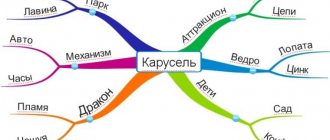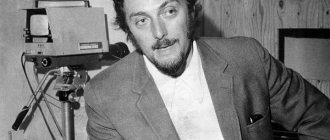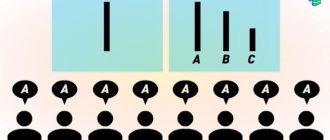But you shouldn’t think that psychology is one big house that lives according to the same laws. There are many scientific schools in this science that look at the mechanisms of our psyche from their own special angle. One of these schools is associative psychology.
This school understands the mental process, its functioning and dynamics through associations. Association is a psychological term that characterizes a certain process on which thinking is largely based; it is associated with the fact that the appearance of one thought or one image can cause the appearance of another thought or another image.
Main points
The term “associationism” was introduced in the 17th century by the English thinker Locke. The concept itself became widespread half a century later, although the method of representing the work of the brain using similar images was described by Aristotle and Plato. Representatives of associationism endowed this principle with the role of the leading or only mechanism for the activity and development of the human psyche and consciousness.
It is noteworthy that for Locke, the founder of the empirical study of the psyche, all the phenomena of mental activity he examined related to the individual experience of a particular person, that is, the scientist consciously excluded from his research the essence of the soul and its influence on the personality.
Are you ready to stop thinking about your problem and finally move on to real actions that will help you get rid of your problems once and for all? Then perhaps you will be interested in this article .
Locke considered association to be the key mechanism for the emergence of complex ideas. The associationist theory included any complex thoughts (decisions/ideas) that “are often combined in such a way that they cannot be separated later” as a combination of ideas that are incorrect, that is, not consistent with the natural existence of a person.
An example of an association according to Locke is:
- sympathy;
- superstitions;
- antipathies.
The philosopher introduced the term in a very limited way. This was followed by active development of this mechanism of consciousness, which resulted in the emergence of associative psychology.
Locke approved the following scheme for the emergence of ideas through association:
- Sensations in the process of development precede mental activity.
- Simple ideas are combined through associations into more complex ones.
- Experience becomes the basis of knowledge, the sources of experience are reflection and sensations.
- There are no innate associations.
The concept began to be actively used in pedagogy, and over time it was developed in personality psychology. The psychological school of associationism seeks to establish an exclusively causal study of individual behavior.
The direction is based on the thesis about the sequence of ideas that reflect the impact of external factors on a person.
Very strict postulates have been replaced by theories that originate from the ideas of Rousseau and assign a key role in the formation of personality to the internal features of human development.
By the beginning of the 19th century, the principles of associationism were formed:
- the concept of soul is something capable of knowledge;
- the psyche consists of the simplest elements - sensations;
- complex thoughts arise from associations from simple parts;
- all knowledge about the soul is the result of introspection. A person can only study his own world; the inner spiritual life of another person is not accessible to outsiders.
For associationism, each person is represented as a loner who lives in a community of loners. The inner world of the individual is opposed to the external environment, and there is a hard line between them.
Advances in science at the turn of the 19th and 20th centuries brought changes to the perception of the psyche by associationists. Some scientists have introduced additional aspects to the study of human mental activity.
Thus, Darwin changed the interpretation of the manifestation of emotions, Sechenov developed the doctrine of brain reflexes.
In modern psychology, associationism is considered an important movement in which a strictly causal approach is applied to the study of human behavior. Association becomes the main mechanism of psychological activity of the individual. Thinking comes down to combining several images in memory with associations (by contrast with the object, by similarity, etc.).
Experiment
The ideas of Hartley and Hume, as well as other representatives of associative psychology, migrated to other directions and became the basis for new research.
One of these was the associative experiment in psychology, its development was carried out by E. Kremelin, K. Jung, W. Wundt and other researchers. This method is used both to study the interaction of people in a group and to study the internal processes of an individual. Thanks to the dynamics that are set in the experiment, the subject makes involuntary associations. And they are the basis for studying the thought process of both a given person and a group of people.
We recommend: Define your archetype
The association experiment is widely used in various fields of psychology to obtain reliable information:
- It is used as a method of speech analysis, namely to study the vocabulary of the subject. To do this, subjects are presented with a list of words (about a hundred) and are asked to write their own association for each word (the first word that comes to mind) - no more than 10 minutes are allotted for this experiment.
- It is also used in psychophysiological studies to assess the correct understanding of stimuli. For example, a subject is presented with a certain stimulus (usually a word) and attention is paid to his physiological reaction - for example, how quickly the subject begins to salivate after the researcher says the word “lemon”.
- As a method of analyzing interaction within a group, to understand who is the leader and who is the outsider, as well as how cohesive the group is.
- It is interesting that the experiment in question is also actively used in criminology: with the help of associations, a suspect’s involvement in a particular crime is determined. In such cases, “reliable” are those associations that the suspect makes immediately, without thinking, since thinking can lead to false data.
As you can see, this experiment is used quite widely and in completely different areas of modern psychology. We should not forget that in many ways associations demonstrate not only the conscious part of our psyche, but also the subconscious. It is not for nothing that this method was used by psychoanalysts, whose subject of study was our unconscious.
Association as connection
In the context of psychology, the word means the spontaneous connection of two objects in the brain. A connection between a memory and a fictitious image, between objects, can be created unconsciously without reference to a specific stimulus.
The appearance of connections is influenced by:
- external factors (smell, expression, visual image, sound);
- a person's own experiences and memories.
Life processes become the causative agent for the emergence of the association. Thus, unpleasant sensations in the stomach create an association with the food eaten.
A person’s thoughts can create several images or a chain of them. You can often notice that one thought “attracts” a second, a third, and so on. With this action, the brain presents a person with a connection of associations for a specific thought. The student solves the problem, in the process of calculations the audience and his classmates come to mind, this is followed by thinking about a specific person - the chain of thoughts can last indefinitely until the person forces himself to return to the original idea.
Developmental psychology and cultural-historical theory of Vygotsky L.S.
The theory of the origin and development of higher mental functions was developed by L.S. Vygotsky. The fundamental idea of this theory is the social mediation of human mental activity. The instrument of this mediation is, according to Vygotsky, a sign (word).
In his opinion, “Man, in the process of his historical development, has risen to the point of creating new driving forces of his behavior: thus, in the process of man’s social life, his new needs arose, formed and developed, and the natural needs of man in the process of his historical development have undergone profound changes” [5, p.85].
According to the theory of L.S. According to Vygotsky, a person has 2 lines of development:
natural and cultural. The natural developmental line is the physical, natural development of a child from the moment of birth. With the emergence of communication with the outside world, a cultural line of development arises.
Lev Semenovich believed that a person does not have an innate form of behavior in the environment. Its development occurs through the appropriation of historically developed forms and methods of activity. He postulated a structural analogy between objective and internal mental activity. The internal plane of consciousness began to be understood in Russian psychology as the external world mastered by activity.
L.S. Vygotsky was the first to move from a statement about the importance of the environment for development to identifying a specific mechanism of environmental influence, which actually changes the child’s psyche, leading to the emergence of higher mental functions specific to a person. He considered such a mechanism to be the internalization of signs - man-made incentives and means designed to control one’s own and others’ behavior.
Types of associative connectives
Aristotle was the first to create a classification of images; his typology is also used by modern psychologists.
The thinker divided associative connections into 3 groups:
- Contiguity is a common type of image appearance that appears with the regular perception of several objects at the same time. The sound of water can be associated with relaxation, the aroma of baking - with home. This type of connectives includes verbal images that can be formed from idioms and sayings. Along with the emergence of the word “oak,” the association “mighty” may appear. Cohesion by contiguity is more often manifested through an actual connection between objects and/or actions. Stars are associated with the night, gloves with hands.
- Similarity . For such a connection to occur, objects must be similar in one or more characteristics: color, shape, emotional response of the individual to objects, etc. The sky evokes a connection with the sea, a snow-covered meadow with a white cloth.
- Contrast . The most complex type, little studied, unsubstantiated scientifically. A connection with an image arises in consciousness as a reaction to its opposition to an object or phenomenon. Most people remember winter when they mention summer, and when they hear the word “light,” they remember darkness.
At the end of the 19th century, the ancient classification was supplemented with a type of associations based on meaning. Such connections are the result of data analysis and the emergence of complex images in the human mind.
Semantic associations in most cases are individual and determined by personal experience. So, a person can associate a cough with winter, a train with the sea.
Methods of carrying out
It is also important to understand that an associative experiment can take place in different ways. There are three main ways to conduct this experiment:. 1
No limits. Here the subject can freely express his associations both orally and in writing. The only limitation may be the number of associations
1. No restrictions. Here the subject can freely express his associations both orally and in writing. The only limitation may be the number of associations.
2. Having a direction. In this case, the researcher limits and thereby directs the flow of associations of the subject (for example, it is necessary to name associations only in the form of adjectives).
3. Along the chain. The main limitation here is time. For one stimulus, a person must make several associations in a chain at once; usually the subject is given only a couple of minutes for this.
Recommended: What is an alternative?
After the experiment, data is collected, analyzed, and conclusions are drawn - for example, regarding the associative norm. Frequent reactions to stimuli in the sample will be considered the norm, something familiar to the majority, but isolated cases will be considered a rarity. The most common reactions are formed into an associative field, which is then used in subsequent experiments.
This method is one of the simplest and most accessible in psychology - moreover, the data obtained from this experiment are quite reliable. After all, in order to “launch” the flow of associations in a subject, nothing is needed except the stimulus words themselves.
Personal connection tools
Associations are based on conditioned reflex reactions. Each external stimulus causes the appearance of a focus of excitation in the cerebral hemispheres of the cerebral cortex.
These factors are:
More than 9,000 people have gotten rid of their psychological problems using this technique.
- smells;
- words;
- sounds;
- tactile sensations;
- thoughts.
In the lesion, an electrical impulse passes through the neurons, which spreads across areas of the cerebral cortex. During this period, traces of previous passages of the impulse are activated and images that arose earlier upon contact with the object are recalled from memory.
The process of creating associations is necessary for the normal functioning of consciousness and increasing the efficiency of thinking, and is regulated by several tools:
- Memory and the information stored in it. Strengthening memory and expanding horizons create the opportunity for more quality associations to emerge. The result is the development of diverse and new connections.
- Imagination , which processes information, changes and combines combinations of elements in new forms of images. The work of imagination enriches a person’s memory; the resulting associations are used in thinking.
- The speed of passage of a nerve impulse or the occurrence of nervous processes, which regulates the speed of reflex reactions. Greater speed forces the brain to quickly create associations, the variety of which depends on the person’s level of knowledge.
- Unconscious . The process of creating connections is based on the sudden spread of excitation deep into the cerebral cortex and connects the subconscious to thinking. Due to the fact that a large amount of information is stored in this area of perception, associations are an opportunity to interact with the unconscious.
The set of associations is individual for each person, as it is created under the influence of the individual’s experience and knowledge.
Gestalt psychology.
Gestalt psychology owes its appearance to the German psychologists Max Wertheimer, Kurt Koffke and Wolfgang Köhler, who put forward a program for studying the psyche from the point of view of holistic structures - gestalts. Opposing the principle put forward by psychology of dividing consciousness into elements and constructing complex mental phenomena from them, they proposed the idea of the integrity of the image and the irreducibility of its properties to the sum of the properties of the elements. According to these theorists, the objects that make up our environment are perceived by the senses not as individual objects, but as organized forms. Perception is not reduced to the sum of sensations, and the properties of a figure are not described through the properties of its parts. Gestalt itself is a functional structure that organizes the diversity of individual phenomena.
Studying human thinking, Gestalt psychologists proved that mental operations when solving creative problems are subject to special principles of Gestalt organization (“grouping”, “centering”, etc.), and not to the rules of formal logic.
So, “consciousness was presented in Gestalt theory as an integrity created by the dynamics of cognitive structures that are transformed according to psychological laws” [4, p. 113].
Namespace
There are well-established connections that are inherent in society and the linguistic environment. These images include the name space. Most of the modern names have ancient origins and are therefore associated with their original meaning.
In national cultures, names are often associated with a certain character trait (or appearance).
An example in Russian culture is the name Catherine; the word, due to the historical characteristics of the country’s development, receives a connection with “great” and with the original meaning “immaculate.”
The perception of the estate is influenced by its famous bearers. A famous example of an association in space named after Louis “the Sun” XIV is the French king. The rulers of the dynasty received this name over several centuries. Because of this, when many people mention the name, they associate it with royal attributes, Paris, France.
Many cultures have their own list of “unlucky names.” For example, these are the names of Christian martyrs - Tatyana, Fedor (although this tradition was not very widespread in Rus'). Such lists create negative associations that can spread and strengthen, deliberately predetermining the negative connotation of emerging connections.
A name space is a conditional set of generally accepted associations that can be positive or negative. This area is influenced by known bearers of a particular name.
11.2. Concept of personality b.G. Ananyeva
B.G. Ananyev believes that the personality structure includes the following properties:
a certain complex of correlated properties of an individual (age-sex, neurodynamic, constitutional-biochemical); the dynamics of psychophysiological functions and the structure of organic needs, also attributed to individual properties. The highest integration of individual properties is represented in temperament and inclinations; status and social functions-roles; motivation of behavior and value orientations; structure and dynamics of relationships.
Application of associationism in psychology
Suddenly appearing neural connections in the cerebral cortex have been used by doctors to identify mental disorders since the beginning of the 20th century.
The first psychoanalyst to draw attention to the connection with unconscious processes and emerging images was Freud.
His doctrine states that this very deep level of the psyche holds hidden desires and instincts that do not conform to public moral standards. Freud argued that suppression of desires causes phobias, mental and physical illnesses.
In modern psychological diagnostics, associations are used to determine the mental state of an individual.
Representatives of associationism, unlike Freudians, do not work with free images, but with organized phenomena that are controlled by a doctor.
The possibilities of using associationism in diagnostics are divided into 3 groups:
- Verbal connections and images . An example is the paired association test, in which a person needs to pair words according to their meaning (concept-meaning link) and according to phonetic similarity (starting with the same letter). Verbal tests offer the patient a set of words or expressions to which he needs to say the first word that comes to mind.
- Visual associations . A person studies the proposed images, in most cases abstract, then reports what the selected picture reminds him of. An example is the Rorschach test (Ink Blots).
- Creative impulses . To identify unconscious images, the subject is asked to draw anything or write a story on a specific topic. Creativity frees up thinking and allows the subconscious to connect to the work. Therefore, associations arise faster, and the process of studying already formed ones becomes easier.
Associationism considers images as the main resource of information about the individual and a prerequisite for the development of human intelligence and creative thinking.
Your health is our goal
"VitaPortal" occupies one of the first places among the official medical sites in RuNet in terms of the number of users. For many of them, we have become their favorite medical site, and we strive to justify their trust by constantly updating and updating information about human health. Our mission is to create more healthy people. And providing verified information is our way to achieve our goal. After all, the more informed our user is, the more careful he will be with his main asset - health.
The VitaPortal team includes certified doctors and experts in their fields, candidates and doctors of medical sciences, health journalists
Installation theory (D.N. Uznadze)
An attitude is an unconscious psychological state, an internal quality of a subject based on his previous experience, a predisposition to a certain activity in a certain situation. The attitude precedes and determines the development of any form of mental activity. It acts as a state of mobilization, readiness for subsequent action. It is determined by the corresponding situation and the subject’s need to satisfy it. The presence of a person’s attitude allows him to react in one or another specific way to a particular political or social event or phenomenon.
The phenomenon was discovered by the German psychologist Ludwig Lange; the general psychological theory of attitude, based on numerous experimental studies, was developed by D. N. Uznadze and his school (1956).
The stages of attitude formation are most fully revealed on the basis of the concept of contrast illusion. Along with the unconscious simplest attitudes, more complex social attitudes, value orientations of the individual, etc. are distinguished.
Uznadze's set theory originated and developed as a theory describing one of the forms of unconscious nervous activity. He tried to explain the phenomena of perception, as a reflection of reality, and the behavior of a living being. It gradually became obvious that the facts and patterns considered by the theory of attitudes were general psychological in nature. Therefore, attitude theory began to claim the role of a general psychological concept.










